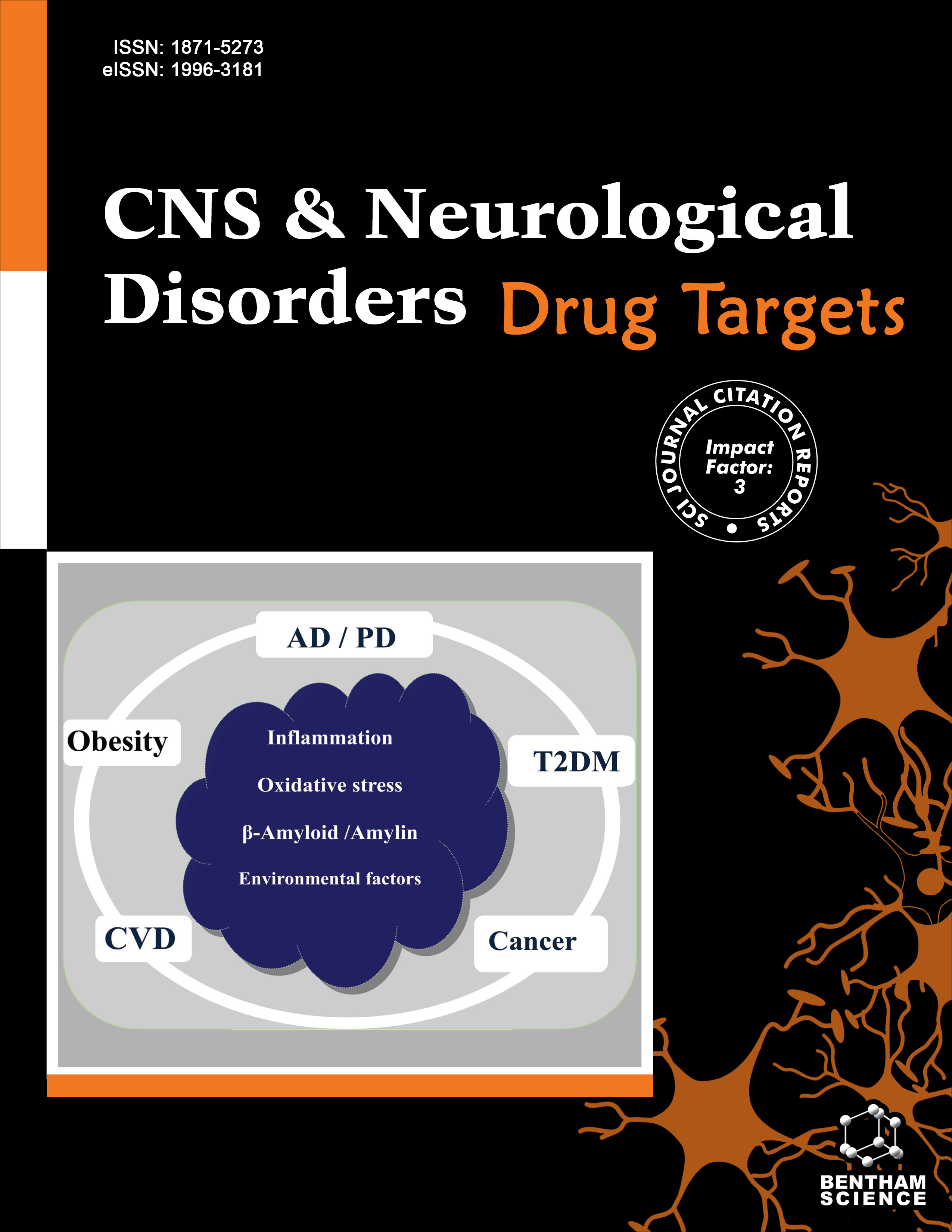- Home
- A-Z Publications
- CNS & Neurological Disorders - Drug Targets (Formerly Current Drug Targets - CNS & Neurological Disorders)
- Previous Issues
- Volume 7, Issue 4, 2008
CNS & Neurological Disorders - Drug Targets (Formerly Current Drug Targets - CNS & Neurological Disorders) - Volume 7, Issue 4, 2008
Volume 7, Issue 4, 2008
-
-
Drugs Used to Treat Parkinson's Disease, Present Status and Future Directions
More LessParkinson's disease (PD) is the second most common neurodegenerative disorder, after Alzheimer’s disease. In PD' motor symptoms result from the degeneration and loss of pigmented dopaminergic neurons of the substantia nigra pars compacta of the basal ganglia. Other neuronal fields and neurotransmitter systems are also involved, including nonadrenergic, serotonergic and cholinergic neurons. Since the early 1960s t Read More
-
-
-
Seizures and Sodium Hydrogen Exchangers: Potential of Sodium Hydrogen Exchanger Inhibitors as Novel Anticonvulsants
More LessAuthors: A. Ali, F. J. Ahmad, Y. Dua, K. K. Pillai and D. VohoraAdvances in the understanding of mechanisms underlying the pathophysiology of epilepsy have led to the identification of sodium hydrogen exchanger (NHE) as one of the possible targets for future antiepileptic drugs (AEDs). There are indicators from several experimental studies that NHE inhibitors could be of significant value as potential anticonvulsants. Various in-vitro reports (brain slices) have suggested anticonvuls Read More
-
-
-
Focus on the Role of Glutamate in the Pathology of the Peripheral Nervous System
More LessAuthors: Valentina Carozzi, Paola Marmiroli and Guido CavalettiThe role of Glutamate (Glu), one of the major excitatory neurotransmitters in the central nervous system, has been thoroughly investigated in animal models and in humans in several physiologic events, such as brain development and synaptic plasticity, but also in acute and chronic neurologic diseases and psychiatric disorders. Recently, it has been demonstrated that Glu is important for sensory input transduction, p Read More
-
-
-
Adult Stem Cell Therapy for Acute Brain Injury in Children
More LessAuthors: James E. Carroll and Cesar V. BorlonganAdult stem cell therapy has been proposed for brain injury in young children. While there have been no clinical trials in the US, the therapy is widely advertised and anecdotally reported in multiple internet sources, leading families to seek the treatment in uncontrolled circumstances. The purpose of this review is to present a discussion of the various types of stem cell preparations, with emphasis on adult stem cells, the scientific b Read More
-
-
-
Transglutaminase-Catalyzed Post-Translational Modifications of Proteins in the Nervous System and their Possible Involvement in Neurodegenerative Diseases
More LessAuthors: G. De Vivo and V. GentileTransglutaminases are a large family of related and ubiquitous enzymes which catalyze the cross-linking of a glutaminyl residue of a protein/peptide substrate to a lysyl residue of a protein/peptide co-substrate. These enzymes are also capable of catalyzing other reactions important for the cell viability. The distribution and the physiological roles of the human transglutaminases have been widely studied in n Read More
-
-
-
Clinical Potential of Minocycline for Schizophrenia
More LessMinocycline, an antibiotic of the tetracycline family, has been shown to display neurorestorative or neuroprotective properties in various models of neurodegenerative diseases. In particular, it has been shown to delay motor alterations, inflammation and apoptosis in models of Huntington's disease, amyotrophic lateral sclerosis and Parkinson's disease. Despite controversies about its efficacy, the relative safety and tolerabilit Read More
-
-
-
Brain Adaptation to Stressful Stimuli: A New Perspective on Potential Therapeutic Approaches Based on BDNF and NMDA Receptors
More LessAuthors: Ann M. Marini, Margherita Popolo, Hongna Pan, Nicolas Blondeau and Robert H. LipskyA variety of sublethal or stressful stimuli induce a phenomenon in the brain known as tolerance, an adaptive response that protects the brain against the same stress, or against a different stress (cross-tolerance). Understanding the molecular mechanisms of brain preconditioning holds promise in developing innovative therapies to prevent and treat neurodegenerative disorders, particularly ischemic stroke. Many of the Read More
-
Volumes & issues
-
Volume 24 (2025)
-
Volume 23 (2024)
-
Volume 22 (2023)
-
Volume 21 (2022)
-
Volume 20 (2021)
-
Volume 19 (2020)
-
Volume 18 (2019)
-
Volume 17 (2018)
-
Volume 16 (2017)
-
Volume 15 (2016)
-
Volume 14 (2015)
-
Volume 13 (2014)
-
Volume 12 (2013)
-
Volume 11 (2012)
-
Volume 10 (2011)
-
Volume 9 (2010)
-
Volume 8 (2009)
-
Volume 7 (2008)
-
Volume 6 (2007)
-
Volume 5 (2006)
Most Read This Month
Article
content/journals/cnsnddt
Journal
10
5
false
en

Most Cited Most Cited RSS feed
-
-
A Retrospective, Multi-Center Cohort Study Evaluating the Severity- Related Effects of Cerebrolysin Treatment on Clinical Outcomes in Traumatic Brain Injury
Authors: Dafin F. Muresanu, Alexandru V. Ciurea, Radu M. Gorgan, Eva Gheorghita, Stefan I. Florian, Horatiu Stan, Alin Blaga, Nicolai Ianovici, Stefan M. Iencean, Dana Turliuc, Horia B. Davidescu, Cornel Mihalache, Felix M. Brehar, Anca . S. Mihaescu, Dinu C. Mardare, Aurelian Anghelescu, Carmen Chiparus, Magdalena Lapadat, Viorel Pruna, Dumitru Mohan, Constantin Costea, Daniel Costea, Claudiu Palade, Narcisa Bucur, Jesus Figueroa and Anton Alvarez
-
-
-
- More Less

